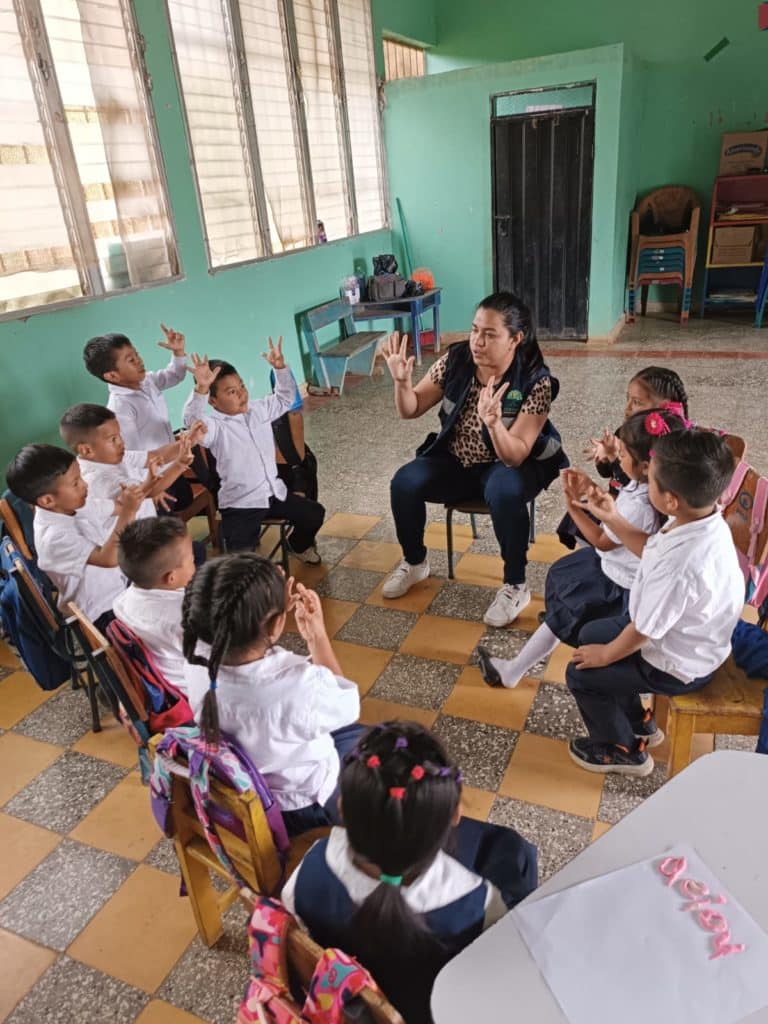Article Summary
Arman has been going to school for a year and he is doing well in class. This is not a given since many children who grow up in difficult socio-economic conditions in India lack access to quality education.
His parents are convinced that the reason he is doing so well in school is because of the early education classes he attended. Arman was able to attend one of the 50 early childhood development centres which were set up by the Swiss Academy for Development (SA4D) and the local implementing partner Centre for Rural Education and Development Action (CREDA) as part of the «Move & Improve» project in India. There, teachers use the sport and play approach to support children in their holistic development.
This article tells Arman’s story and provides insights into the «Move & Improve» project. The article was written for the Childhood Education Innovations Magazine (May/June 2023 issue).
Author: Gabriel Dietrich, Swiss Academy for Development (SA4D)
SA4D WAS GIVEN THE OPPORTUNITY TO WRITE AN ARTICLE FOR CHILDHOOD EDUCATION INNOVATIONS MAGAZINE ABOUT THE EARLY CHILDHOOD EDUCATION PROJECT IN INDIA, MOVE & IMPROVE. IT WAS PUBLISHED IN THE MAY/JUNE 2023 PUBLICATION. THE ARTICLE TELLS THE STORY OF ARMAN, A 7-YEAR OLD BOY WHO ATTENDS CREDA’S EARLY CHILDHOOD DEVELOPMENT CENTRES IN MIRZAPUR, INDIA.
Arman has been going to school for a year. His teacher is pleased with him. Unlike other children, he listens carefully and does his work independently. “He always does his homework by himself too,” say his parents. It is not a given that the seven-year-old would find school easy. His mother can neither read nor write, and his father only went to primary school for a couple of years, which makes it difficult for them to support their five children. But one thing was always clear to them – they want their children to have a good education and a better life than theirs.
Arman and his parents
Access to quality education is not always given for children from the lowest socioeconomic background in India. The lack of infrastructure and of trained teachers as well as precarious living conditions and poverty often impede children from the most disadvantaged areas to go to school regularly or at all. For those who do access school, the teaching methods and conditions do not always provide a favourable learning environment and are quite challenging especially for children without sufficient support at home. To get through the Indian school system children are required to be resilient and already have ease in learning – qualities that children from poorer backgrounds often lack. As a result, one in four children does not complete primary school.[i] This is especially true for children living in and around Mirzapur, in the southeast of Uttar Pradesh, the state with the lowest school attendance rates in India and where Arman has been growing up.[ii]
Village close to Mirzapur, Uttar Pradesh, India.
EARLY CHILDHOOD DEVELOPMENT FOR A GOOD START IN SCHOOL
One way to address this issue is by preparing children for school early on: early childhood education (ECE) can have a lasting positive effect on a child’s later success in school and in life – and can even mitigate the disadvantages, such as poverty, discrimination, or illness some children may have at the start of their life. This is because the first six years of a person’s life are considered the most crucial for their development. The environment children grow up in, the encouragement they get and the activities they do during this time can determine later health and educational outcomes as well as social and economic participation in adult life. Movement and stimulation promote brain development in young children. Neglect, stress and malnutrition lead to developmental delays, which can be difficult to compensate for later in life and can even have irreversible consequences.[iii] Early childhood development lays the foundations for children to reach their full potential and can contribute to breaking the vicious circle of poverty.
The Indian government has recognised the potential of early childhood education. Since 2005, early childhood education centres are being built across the country, which also offer government services such as health checks, vaccinations and nutritional advice.[iv] Even though the number of children attending these centres has tripled between 1999 and 2010, with 70% of 3-year-olds and more than 85% of 4-year-olds attending a centre in 2018, disadvantaged children are still significantly underrepresented. Particularly in the countryside, where such centres and services are still scarce.[v] Despite the government’s efforts, the children who would potentially benefit the most from early childhood education remain excluded. However, as Arman’s story will show, there are ways in which also the most disadvantaged children can be supported in their development. With only few resources, their learning gaps can be addressed, and they can get a chance at succeeding in school.
MOVE & IMPROVE: EARLY CHILDHOOD EDUCATION CENTRES AND PARENTAL AWARENESS IN MIRZAPUR
Arman’s success in school defies the above-mentioned rather grim statistics. His parents are convinced that his doing so well in school is related to the early year classes he went to. Arman was able to attend one of the 50 early childhood development centres which were set up by the Swiss Academy for Development (SA4D) and the local implementing partner, Centre for Rural Education and Development Action (CREDA). CREDA and SA4D are working together in the “Move & Improve” project to ensure that children’s right to education is respected and to fill a gap in preparing children for regular primary school in areas with little to no access to government-run early childhood development centres.
CREDA conducting a training for early childhood development teachers to learn more about holistic and playful teaching approaches.
To achieve long-term social and structural change, CREDA and SA4D are taking a holistic approach. This approach puts the child’s needs at its centre and considers the cognitive, physical, emotional and social dimensions of their development. In addition, CREDA and SA4D not only support disadvantaged children in accessing education, they also engage with the parents and the community to raise their awareness on how to support children in their schooling. This is because for children to succeed in school, every aspect of their environment must be considered, with schools being just one of many influencing factors. In growing up, children are shaped by their parents, their families, their friends, and many other people in their community. Thus, it is important to consider the context in which children live and learn.
For children’s education to become a crucial point in a community, SA4D and CREDA encourage parents, caregivers and community members to participate in parenting awareness raising sessions addressing the importance of education and childcare, especially for girls. Furthermore, they train early childhood development teachers to incorporate a holistic and playful approach in their daily classroom activities. Positively influencing the way in which education is perceived in the community also has an additional benefit: working closely with the community and in line with people’s needs allows for change to last. By offering a safe and favourable learning environment, in- and outside of the classroom, this project aims to allow children to reach their full potential – for children now and for the ones yet to come.
One of the teachers doing the “touch and feel” activity with the children, which stimulates curiosity and senses in a playful way.
HOLISTIC DEVELOPMENT THROUGH SPORT AND PLAY
The ECD centres that are run by SA4D and CREDA use sport and play as tools for holistic development, because the role of play is central in child development. The aim is to promote children’s development, supporting their cognitive, physical, emotional and social skills. Those four dimensions are needed to fully develop and succeed at school in the long term:
Cognitive: Play stimulates a child’s natural curiosity and desire to learn and works for different types of learners. By providing opportunities to try new things, to solve problems, to invent, to create and to test ideas, children are encouraged to explore and understand the world around them. In a playful environment, they learn to concentrate, to observe, to reflect and to anticipate. Furthermore, these activities foster logical and strategic thinking, decision-making and problem-solving. Finally, play has a positive effect on children’s language development; it improves listening skills, as well as their vocabulary and verbal expression.
Physical: Through movement and dexterity games, children develop physical abilities and motor skills. They improve their body awareness, balance, rhythm, as well as their coordination, orientation, and reaction skills. In addition, allowing children to move regularly, supports them in becoming more flexible, stronger and more resilient.
Emotional: In a protected environment, children become aware of their emotions and learn to manage them, too. Winning and losing enhances their ability to cope with negative feelings, such as fear and frustration, or aggression. Through painting, crafts and role plays, they learn to recognize and communicate their feelings. At the same time, their self-confidence is developed.
Social: By playing with others, children can make friends with their peers and develop trusting relationships with adults. They learn to resolve conflicts, negotiate, cooperate with others, as well as to obey rules and act as part of a team. Care workers can explain stereotypes and prejudices and equip children with the basis for a critical understanding of these concepts.
By focusing on these four dimensions of child development, the gap between home and school is reduced and children are mentally, emotionally, socially and physically prepared for entering the formal, government-run school system. In combination with raising parents’ awareness about the importance of education – especially for girls, the activities provide all the necessary care and support for children to grow, learn and develop to their full potential.
The early childhood development centres have toys made from locally available materials.
In addition, all sport and play materials can be made by the facilitators or the parents themselves: for example, balls, dolls, hand and finger puppets can be created with locally available materials such as clay, wooden sticks or old cloth. No special equipment is needed to provide children with fun learning opportunities to prepare them for school. This makes the approach especially suited for communities with only scarce resources.
A LASTING DIFFERENCE
For Arman, attending the early childhood development centre was a great success. He is the youngest in the family and the only one to have attended preschool. Before “Move & Improve”, there were no free early year’s classes in the village. He first attended the classes when he was four years old. Once he got used to the activities, his parents noticed that he liked doing them when he was at home, too. For example, he learnt how important handwashing and tooth-cleaning are. “Suddenly we didn’t need to remind him anymore – he did everything by himself.” Although Arman likes school, he misses preschool. He doesn’t hesitate long when asked why: “The games!”
Notes:
[i] USAID, Dropout trend analysis: India, 2011, pages 14-18
[ii] According to UNICEF India, the RTE contributed to reducing by more than half the number of out of school children. However, the majority of the remaining 6 million children out of school across India come from the most marginalized communities and 75% of them live in only 6 (including Uttar Pradesh) of the 28 Indian states (https://www.unicef.org/india/key-data).
[iii] Milteer, R. M., Ginsburg, K. R., Council on Communications and Media, & Committee on Psychosocial Aspects of Child and Family Health. The importance of play in promoting healthy child development and maintaining strong parent-child bond: Focus on children in poverty. Pediatrics, 129, e204–e213
[iv] Government of India, Ministry of Women and Child Development, National Early Childhood Care and Education Policy, 2013
[v] Annual Status of Education Report. ASER 2020 http://img.asercentre.org/docs/ASER%202021/ASER%202020%20wave%201%20%20v2/state%20estimates/uttarpradesh.pdf







